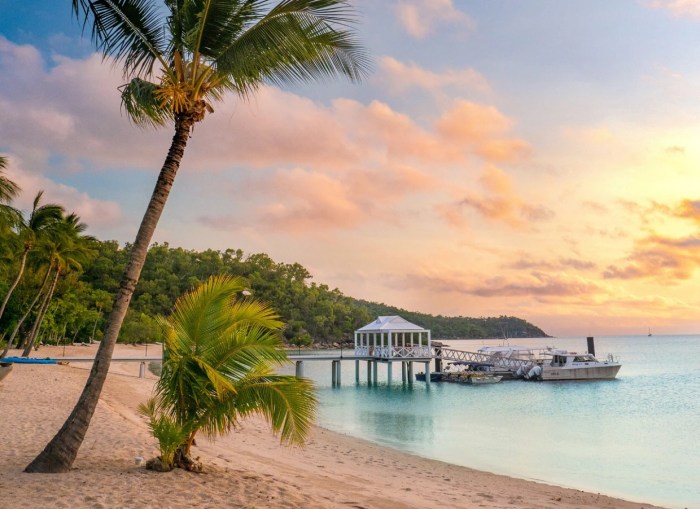Great Barrier Reef lost coral is a stark reality, highlighting the devastating impact of climate change and human activities on this vital ecosystem. Rising ocean temperatures trigger coral bleaching events, leading to widespread coral mortality. This loss isn’t just about coral; it affects the entire marine food web, impacting fish populations, biodiversity, and even coastal economies. Understanding the causes, consequences, and potential solutions is crucial to safeguarding this natural wonder.
This article explores the complex issue of coral loss, delving into the science behind bleaching events, the alarming mortality rates, and the ripple effects on the marine ecosystem. We’ll examine human activities contributing to this crisis and discuss the crucial restoration and conservation efforts underway. Ultimately, we aim to understand the future of the Great Barrier Reef and what can be done to protect it.
Coral Bleaching Events
The Great Barrier Reef, a vibrant ecosystem, is facing increasing threats from coral bleaching events. These events, driven primarily by rising ocean temperatures, cause significant damage to coral reefs, impacting marine biodiversity and the delicate balance of the reef’s ecosystem. Understanding the causes, mechanisms, and impacts of bleaching is crucial for developing effective conservation strategies.
Causes of Coral Bleaching Events
Coral bleaching occurs when corals expel the symbiotic algae (zooxanthellae) living within their tissues. This expulsion results in the coral’s loss of color, making them appear white or pale. Several factors contribute to these events, with rising ocean temperatures being the primary driver. Other contributing factors include pollution, sedimentation, and ocean acidification. The combined effects of these stressors can weaken coral resilience and increase the likelihood of bleaching.
Mechanisms of Bleaching by Rising Temperatures
Rising ocean temperatures disrupt the symbiotic relationship between corals and zooxanthellae. Zooxanthellae provide corals with essential nutrients through photosynthesis, while corals offer shelter and nutrients. When water temperatures exceed a certain threshold, corals expel the algae to protect themselves. This expulsion results in the coral’s loss of color and its ability to feed and grow. The stress imposed by elevated temperatures compromises the coral’s immune system, making it more vulnerable to other diseases and environmental stresses.
Frequency and Severity of Bleaching Events
The frequency and severity of coral bleaching events have significantly increased over the past few decades. Historical records and scientific studies show a clear correlation between rising ocean temperatures and the increased occurrence of bleaching events. The severity of these events can vary, impacting different coral species and reef regions differently.
Observable Effects on Coral Species
Coral bleaching has various observable effects on different coral species. Some corals exhibit a complete loss of color, while others show partial bleaching, with varying degrees of recovery. The effects can range from temporary discoloration to long-term mortality, depending on the severity and duration of the bleaching event. Severe bleaching events can cause significant mortality, particularly in sensitive coral species.
This mortality can disrupt the entire reef ecosystem, affecting fish populations and other organisms that depend on the coral for shelter and food.
Monitoring and Predicting Future Bleaching Events
Monitoring coral health and predicting future bleaching events are crucial for effective conservation strategies. Scientists employ various methods, including satellite imagery, underwater surveys, and coral monitoring programs, to track coral health and identify areas at high risk. Advanced modeling techniques are used to project future temperature scenarios and predict the likelihood of bleaching events.
Correlation Between Water Temperature and Bleaching Intensity
| Temperature (°C) | Date | Bleaching Severity | Location |
|---|---|---|---|
| 28.5 | 2022-07-15 | Moderate | Central Great Barrier Reef |
| 29.2 | 2022-08-10 | Severe | Northern Great Barrier Reef |
| 28.0 | 2023-06-20 | Mild | Southern Great Barrier Reef |
| 30.0 | 2024-04-25 | Severe | Northern Great Barrier Reef |
Note: This table represents a hypothetical example. Actual data would be more complex and include various factors affecting bleaching severity.
Coral Mortality Rates
Coral reefs, vital marine ecosystems, are facing unprecedented threats. Among these, high coral mortality rates are a significant concern, impacting the overall health and resilience of these intricate communities. Understanding the contributing factors and the resulting impact is crucial for developing effective conservation strategies.High coral mortality rates are a complex issue with various contributing factors. These include stressors such as rising ocean temperatures, ocean acidification, pollution, and disease outbreaks.
The Great Barrier Reef’s coral loss is truly heartbreaking. It’s a global issue, impacting marine ecosystems. Fortunately, there are still amazing places to experience nature’s beauty, like exploring the free activities in Los Cabos, a fantastic alternative getaway destination. Check out some of the top free things to do in Los Cabos, from hiking to enjoying the sunset views.
top free things to do in los cabos While we need to continue advocating for solutions to coral reef conservation, it’s important to appreciate the natural wonders still available to us. The issue of coral bleaching and loss remains a serious concern, however.
Each of these factors can act independently or synergistically to weaken corals and make them more susceptible to other threats.
Factors Contributing to High Mortality Rates
Several factors contribute to the decline in coral populations, including elevated ocean temperatures. Increased water temperatures trigger coral bleaching, a phenomenon where corals expel the symbiotic algae living within their tissues. If the stress persists, the corals can eventually die. Ocean acidification, another significant factor, reduces the corals’ ability to build their calcium carbonate skeletons. Pollution from various sources, including agricultural runoff and industrial discharge, can introduce harmful chemicals and sediments into the water, smothering corals and disrupting their delicate balance.
Impact of Disease Outbreaks on Coral Populations
Coral diseases can decimate entire reef populations. These diseases often manifest as discoloration, tissue loss, or lesions on the coral surface. Some diseases are specific to certain species, while others are more generalist, affecting a wider range of coral types. The spread of these diseases is often exacerbated by environmental stressors, creating a devastating synergy. For example, a coral population already weakened by rising sea temperatures may be more susceptible to a disease outbreak.
Coral Cover Loss Over Time
Monitoring coral cover loss in different reef sections over time provides crucial insights into the impact of these threats. Unfortunately, consistent and long-term data is not readily available for all reef systems globally. However, in some regions, significant declines in coral cover have been documented, with certain reefs losing up to 50% or more of their coral cover within a decade.
These declines vary based on location and the specific stressors present. For instance, reefs near major industrial centers or areas with intensive agricultural practices often show more significant declines compared to remote reefs.
Methods for Estimating Coral Mortality Rates
Estimating coral mortality rates involves various methodologies, each with its own strengths and limitations. Direct observation of coral colonies and recording of mortality events over time is one method. Photographic surveys are also commonly used to track changes in coral cover over time. Advanced techniques like remote sensing, utilizing satellite imagery, can also be employed to assess large areas quickly.
However, these remote methods might need ground-truthing to verify the accuracy of data obtained from afar. Coral mortality rates are not uniform across all reefs; they vary based on the specific environmental conditions and the species of coral present.
Correlation Between Pollution and Coral Mortality
Pollution, stemming from various sources, can directly harm coral reefs. Runoff from agricultural fields, containing excess nutrients like nitrogen and phosphorus, can lead to algal blooms, reducing water clarity and depriving corals of sunlight. Industrial discharge can introduce harmful chemicals, impacting coral health and potentially leading to mortality. Sedimentation from construction or deforestation can smother corals, reducing their ability to obtain food and oxygen.
The Great Barrier Reef is sadly losing a lot of its coral. It’s a devastating loss for marine biodiversity. Fortunately, there are still ways to appreciate the beauty of the natural world, like watching belugas on a live cam from the Arctic, such as beluga live cam arctic sea ice day. Seeing these magnificent creatures in their icy habitat reminds us that the world’s ecosystems, though different, are all interconnected, and the loss of coral in the Great Barrier Reef is a serious wake-up call for us all.
The impact of pollution is directly proportional to the volume and type of pollutants introduced into the marine environment.
Comparison of Coral Diseases
| Disease Type | Symptoms | Affected Species | Impact |
|---|---|---|---|
| White Plague | White, necrotic tissue on coral colonies | Various coral species | Significant mortality, especially in stressed populations |
| Black Band Disease | Dark, band-like lesions spreading across the coral | Various coral species | Often leads to complete tissue loss and death |
| Branching Coral Disease | Tissue loss, particularly on branches of branching corals | Branching coral species | Can lead to significant structural damage and death of the coral |
| Yellow Band Disease | Yellow lesions spreading along the coral surface | Various coral species | Mortality rate can be high, especially in combination with other stressors |
Impact on Marine Ecosystem
The Great Barrier Reef, a vibrant tapestry of marine life, faces a severe threat from coral bleaching and mortality. The loss of coral has far-reaching consequences, impacting not only the coral itself but also the entire ecosystem it supports. This intricate web of life, from tiny plankton to massive whales, is profoundly affected by the decline of coral reefs.The loss of coral structure dramatically alters the delicate balance of the reef ecosystem.
This loss directly impacts the myriad species that rely on coral for food, shelter, and breeding grounds. The cascading effects of coral loss extend throughout the entire marine food web, impacting countless species and their interactions.
Fish Populations
Coral reefs are essential nurseries and feeding grounds for countless fish species. The loss of coral structure removes crucial habitats for fish, leading to a decline in fish populations. This loss of fish is not limited to juvenile fish, but also impacts the adult population, as many species rely on coral for spawning and feeding. Coral reefs provide shelter from predators and ideal locations for spawning and rearing offspring.
The Great Barrier Reef’s coral loss is a heartbreaking issue, highlighting the urgent need for conservation efforts. While contemplating such global environmental challenges, it’s good to remember that there are still incredible places to experience, like exploring the charming streets and historical sites of Lyon, a city bursting with culture and culinary delights. Top things to do in Lyon offer a wonderful escape from the sobering reality of coral bleaching and loss.
Hopefully, appreciating such vibrant destinations can inspire action to protect the Reef’s future beauty.
Effects on the Entire Marine Food Web
Coral reefs are the foundation of a complex and productive marine food web. Coral provides shelter, food, and breeding grounds for a diverse array of species. The loss of coral disrupts this intricate web, affecting everything from microscopic organisms to larger predators. The absence of coral as a food source for some species can lead to starvation and population decline, which in turn impacts the predators that depend on those species for sustenance.
This effect reverberates throughout the food web, potentially causing widespread ecological imbalances.
Other Species Dependent on the Reef
Numerous species rely on the Great Barrier Reef for survival. Sea turtles, for instance, rely on coral reefs for nesting and feeding. Their populations have shown a decline in areas where coral reefs have been severely impacted. Similarly, dugongs and seabirds, which rely on the reef for food and nesting, have also been negatively affected by coral loss.
These declines demonstrate the critical link between coral health and the survival of other species.
Economic Repercussions for Coastal Communities
Coral reefs provide substantial economic benefits to coastal communities. Tourism, fishing, and other industries rely on the health of the reef. The decline in coral has resulted in reduced tourism revenue, decreased fishing catches, and a decline in the overall economy for many coastal communities. The loss of coral reefs not only negatively affects local livelihoods but also disrupts the delicate economic balance of these regions.
Species Diversity Loss in Specific Areas of the Great Barrier Reef
| Area | Species Lost | Date of Loss | Reasons |
|---|---|---|---|
| Central Reef | Staghorn Coral | 2016 | Coral bleaching event |
| Northern Reef | Table Coral | 2017 | Coral bleaching and disease outbreaks |
| Southern Reef | Brain Coral | 2018 | Combined effects of bleaching and destructive fishing practices |
| Northeast Reef | Soft Coral | 2019 | Severe bleaching events and sedimentation |
Importance of the Great Barrier Reef as a Biodiversity Hotspot
The Great Barrier Reef is one of the most biodiverse ecosystems on Earth. It supports a vast array of plant and animal species, many of which are found nowhere else on the planet. The reef’s importance as a biodiversity hotspot cannot be overstated, and its loss would have profound global consequences. The immense variety of life, from microscopic organisms to large marine mammals, makes the Great Barrier Reef a crucial part of the Earth’s overall biodiversity.
Its loss diminishes the global reservoir of genetic diversity and the potential for future discoveries and understanding of life’s intricate processes.
Human Activities and their Impact
The vibrant tapestry of coral reefs, teeming with life, is facing unprecedented threats. Human activities are a significant driver of coral loss, impacting these crucial ecosystems in myriad ways. From the warming waters of climate change to the destructive touch of fishing practices, understanding these pressures is paramount to conservation efforts. The delicate balance of these underwater cities is easily disrupted, with lasting consequences for the entire marine environment.
The Role of Human Activities in Coral Loss
Human activities are profoundly altering the ocean’s chemistry and environment, creating a hostile environment for corals. These activities range from the large-scale effects of climate change to the localized impacts of pollution and destructive fishing. The combined effect of these pressures is a devastating assault on coral reefs globally.
Impact of Climate Change on Coral Reefs
Climate change is a major driver of coral bleaching events. Increased ocean temperatures cause corals to expel the symbiotic algae living within their tissues, leading to their whitening and eventual death. The frequency and severity of these events are increasing, causing widespread mortality and impacting the delicate balance of marine ecosystems. For instance, the 2016 coral bleaching event affected a significant portion of the Great Barrier Reef, showcasing the devastating impact of rising ocean temperatures.
Effects of Pollution on Coral Reefs
Pollution, particularly runoff and sediment, significantly harms coral reefs. Runoff carries excess nutrients, leading to algal blooms that smother corals. Sedimentation, from deforestation and erosion, can cloud the water, reducing the amount of sunlight reaching corals, hindering their growth and survival. The resulting lack of light inhibits photosynthesis in the symbiotic algae, disrupting the crucial relationship between corals and algae.
This disruption is often a significant contributor to coral mortality.
Destructive Fishing Practices
Destructive fishing practices, such as the use of dynamite or cyanide, directly damage coral reefs. Dynamite fishing creates shockwaves that shatter coral structures, while cyanide fishing poisons the surrounding environment, harming or killing a wide array of marine life, including corals. These practices have devastating and lasting effects, reducing coral cover and impacting biodiversity.
Comparison of Human Activities Impacting Coral Health
The impact of various human activities on coral health varies in scale and immediacy. Climate change, with its slow but relentless warming, is a global threat, while localized impacts like pollution and destructive fishing can be far more immediate and concentrated. However, even seemingly small-scale actions can have ripple effects throughout the marine ecosystem.
Correlation Between Human Activities and Coral Damage
| Activity | Damage Type | Location | Impact |
|---|---|---|---|
| Climate Change (Rising Sea Temperatures) | Coral Bleaching | Global | Widespread coral mortality, ecosystem disruption |
| Pollution (Runoff, Sedimentation) | Smothering, Reduced Light Penetration | Coastal Areas | Coral growth inhibition, increased mortality |
| Destructive Fishing (Dynamite, Cyanide) | Physical Damage, Chemical Poisoning | Specific Fishing Zones | Immediate coral death, habitat destruction, biodiversity loss |
| Coastal Development (Construction, Dredging) | Sedimentation, Habitat Destruction | Coastal Areas | Coral growth inhibition, physical damage |
Restoration and Conservation Efforts

The Great Barrier Reef, a vital marine ecosystem, faces significant threats from coral bleaching, human activities, and pollution. Active restoration and conservation efforts are crucial for its survival and the health of the surrounding environment. These efforts encompass a wide range of strategies, from coral cultivation and transplantation to the establishment of marine protected areas and the reduction of pollution.Coral restoration is not a simple fix, but a complex and multi-faceted approach demanding scientific rigor, logistical planning, and ongoing monitoring.
Success hinges on a holistic strategy, encompassing both local and international cooperation to address the various contributing factors impacting the reef.
Current Restoration Efforts
Current restoration efforts for the Great Barrier Reef involve a combination of techniques focused on cultivating and transplanting coral fragments, supporting coral growth, and safeguarding the reef’s health through effective conservation strategies. The initiatives aim to counteract the detrimental effects of bleaching events and human activities, promoting reef resilience and long-term sustainability.
Methods Used to Cultivate and Transplant Corals
Coral cultivation and transplantation methods involve carefully selecting healthy coral fragments, nurturing them in controlled environments (coral nurseries), and eventually transplanting them to suitable locations on the reef. These methods often employ specialized techniques to ensure optimal survival rates and promote coral growth. One approach involves creating artificial reefs using suitable substrates for coral attachment and growth. Another technique focuses on transplanting coral fragments onto existing reef structures, creating coral colonies from fragmented sections.
Furthermore, scientists are exploring techniques to genetically enhance corals for improved resilience against environmental stressors like warming ocean temperatures.
Role of Marine Protected Areas in Conservation
Marine protected areas (MPAs) play a vital role in conserving the Great Barrier Reef. They serve as sanctuaries for marine life, safeguarding coral populations and the wider ecosystem. By limiting or prohibiting destructive activities within these designated zones, MPAs provide a refuge for coral to regenerate and flourish. MPAs also provide crucial data on the health and resilience of the coral reef and its surrounding environment.
Strategies for Minimizing Pollution
Minimizing pollution is a key aspect of protecting the Great Barrier Reef. Reducing runoff from agricultural land and urban areas, improving wastewater treatment facilities, and promoting sustainable fishing practices are vital steps in minimizing pollution. Implementing stricter regulations on industrial discharge and promoting responsible tourism practices are also crucial for reducing pollution levels. Education campaigns for local communities and tourists about pollution awareness are integral in fostering responsible behavior.
Successful Coral Restoration Projects, Great barrier reef lost coral
| Project Name | Location | Methods | Success |
|---|---|---|---|
| GBRMPA Coral Nursery Project | Various locations along the GBR | Coral fragment collection, cultivation in nurseries, transplantation to reef sites. | Demonstrated successful coral growth and survival rates in controlled environments. Long-term results are still being monitored. |
| Coral Restoration Foundation Project | Specific locations within the GBR | Coral fragment collection, cultivation in nurseries, transplantation using artificial structures. | Preliminary results show promising growth rates. Ongoing monitoring is crucial to assess long-term success. |
| Reef Check Australia Projects | Various locations along the GBR | Community-based coral monitoring and restoration efforts. | Contributed to valuable data on reef health, fostering awareness and engagement of local communities. |
| James Cook University Research | Various locations along the GBR | Coral transplantation experiments, developing new methods for coral propagation. | Led to improved understanding of coral propagation, transplantation, and resilience. |
Importance of International Cooperation
International cooperation is essential for the conservation of coral reefs globally. Sharing knowledge, resources, and best practices among nations is crucial in developing effective strategies to address the multifaceted threats facing coral reefs. Joint research efforts, funding collaborations, and coordinated conservation initiatives will be essential for achieving long-term sustainability.
Future Projections: Great Barrier Reef Lost Coral
The Great Barrier Reef, a vibrant ecosystem teeming with life, faces an uncertain future. Continued coral bleaching events, driven by rising ocean temperatures, threaten the very fabric of this magnificent marine wonder. Understanding the potential consequences of continued coral loss, exploring the possibility of adaptation, and considering different mitigation strategies are crucial to charting a path towards a healthier future for the reef.
The fate of the reef isn’t solely dependent on climate change, but also on our collective actions to mitigate its impacts.
Potential Consequences of Continued Coral Loss
The ongoing decline of coral populations has profound implications for the entire planet. Coral reefs are often called the “rainforests of the sea” because of their biodiversity and ecological importance. They provide vital habitat for countless species, supporting a complex food web that extends far beyond the reef itself. The loss of coral directly impacts fish populations, leading to decreased fish stocks and affecting the livelihoods of communities that rely on them for sustenance and income.
Furthermore, coral reefs act as natural barriers, protecting coastlines from erosion and storm surges. Their loss would exacerbate coastal vulnerability, potentially leading to greater damage from extreme weather events.
Potential for Coral Adaptation to Changing Conditions
While some corals display remarkable resilience, their capacity to adapt to rapid environmental changes is limited. The ability of corals to adapt depends on factors like genetic diversity, their capacity to acclimate to warmer temperatures, and the availability of suitable habitats. Studies are exploring the genetic basis of coral resilience, aiming to identify corals with higher tolerance to heat stress.
Understanding these genetic variations could help in breeding and selecting more resilient coral varieties. However, rapid environmental shifts may outpace the corals’ ability to adapt, leading to further declines in their populations.
Possible Scenarios for the Future of the Great Barrier Reef Under Different Climate Change Scenarios
Future projections for the Great Barrier Reef depend heavily on the trajectory of global climate change. Under a high emissions scenario, the reef could face widespread coral mortality, potentially leading to a significant reduction in biodiversity and ecosystem services. This could result in a dramatic shift in the reef’s structure and function, potentially leading to an entirely different ecosystem with less complexity.
Conversely, a lower emissions scenario could allow for greater coral survival and the potential for the reef to recover over time, albeit at a slower pace. Different mitigation strategies will play a crucial role in determining the ultimate fate of the reef. These scenarios underscore the urgency of transitioning to cleaner energy sources and reducing greenhouse gas emissions.
Comparison of Different Mitigation Strategies to Protect Coral Reefs
Various strategies can be employed to mitigate the effects of climate change on coral reefs. These include reducing greenhouse gas emissions, promoting sustainable fisheries management, and implementing marine protected areas. Reducing greenhouse gas emissions through the transition to renewable energy sources is arguably the most crucial mitigation strategy. This is necessary to slow down the rate of ocean warming and reduce the frequency and intensity of coral bleaching events.
Furthermore, effective management of fisheries can help prevent overfishing, allowing coral reefs to recover and maintain their biodiversity. Finally, marine protected areas can provide safe havens for coral populations, enabling them to recover and potentially adapt to changing conditions. The implementation of these strategies requires collaboration among governments, scientists, and communities to achieve optimal results.
Conclusive Thoughts

The Great Barrier Reef, a global treasure, faces a serious threat from lost coral. This loss, driven by a combination of climate change and human activities, has significant repercussions for the marine ecosystem and coastal communities. While the situation is dire, there is still hope. Effective restoration and conservation efforts, combined with global cooperation, are essential to mitigating the damage and securing the future of this iconic reef.
The time for action is now.




